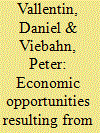|
|
|
Sort Order |
|
|
|
Items / Page
|
|
|
|
|
|
|
| Srl | Item |
| 1 |
ID:
097427


|
|
|
|
|
| Publication |
2010.
|
| Summary/Abstract |
Several energy scenario studies consider concentrated solar power (CSP) plants as an important technology option to reduce the world's CO2 emissions to a level required for not letting the global average temperature exceed a threshold of 2-2.4 °C. A global ramp up of CSP technologies offers great economic opportunities for technology providers as CSP technologies include highly specialised components. This paper analyses possible value creation effects resulting from a global deployment of CSP until 2050 as projected in scenarios of the International Energy Agency (IEA) and Greenpeace International. The analysis focuses on the economic opportunities of German technology providers since companies such as Schott Solar, Flabeg or Solar Millennium are among the leading suppliers of CSP technologies on the global market.
|
|
|
|
|
|
|
|
|
|
|
|
|
|
|
|
| 2 |
ID:
107522


|
|
|
|
|
| Publication |
2011.
|
| Summary/Abstract |
Concentrated solar power (CSP) plants are one of several renewable energy technologies with significant potential to meet a part of future energy demand. An integrated technology assessment shows that CSP plants could play a promising role in Africa and Europe, helping to reach ambitious climate protection goals. Based on the analysis of driving forces and barriers, at first three future envisaged technology scenarios are developed. Depending on the underlying assumptions, an installed capacity of 120 GWel, 405 GWel or even 1,000 GWel could be reached globally in 2050. In the latter case, CSP would then meet 13-15% of global electricity demand. Depending on these scenarios, cost reduction curves for North Africa and Europe are derived. The cost assessment conducted for two virtual sites in Algeria and in Spain shows a long-term reduction of electricity generating costs to figures between 4 and 6 ct/kWhel in 2050. The paper concludes with an ecological analysis based on life cycle assessment. Although the greenhouse gas emissions of current (solar only operated) CSP systems show a good performance (31 g CO2-equivalents/kWhel) compared with advanced fossil-fired systems (130-900 CO2-eq./kWhel), they could further be reduced to 18 g CO2-eq./kWhel in 2050, including transmission from North Africa to Europe.
|
|
|
|
|
|
|
|
|
|
|
|
|
|
|
|
| 3 |
ID:
098531


|
|
|
|
|
| Publication |
2010.
|
| Summary/Abstract |
It is now widely recognized that effective communication and demand-side policies for alternative energy require sound knowledge of preferences and determinants of demand of the public and consumers. To date, public attitudes towards new transport technologies have been studied under very different conceptual frameworks. This paper gives an overview of the various conceptual frameworks and methodologies used, where four main approaches can be distinguished: general attitudinal surveys, risk perception studies, non-market economic valuation studies, and other approaches such as those based on semiotic theory. We then review the findings of the recent literature on acceptance, attitudes and preferences for hydrogen and fuel cell end-use technologies, focusing on vehicles. These studies are then contrasted with related research into alternative fuel vehicles. The paper finally discusses the main trends in research and avenues for further work in this field. We recommend, among other things, the use of approaches that build knowledge and familiarity with the technology prior to the exploration of attitudes, and the set up of studies that take a whole-systems perspective of hydrogen technologies and that look at hydrogen in the context of other competing clean technologies.
|
|
|
|
|
|
|
|
|
|
|
|
|
|
|
|
|
|
|
|
|